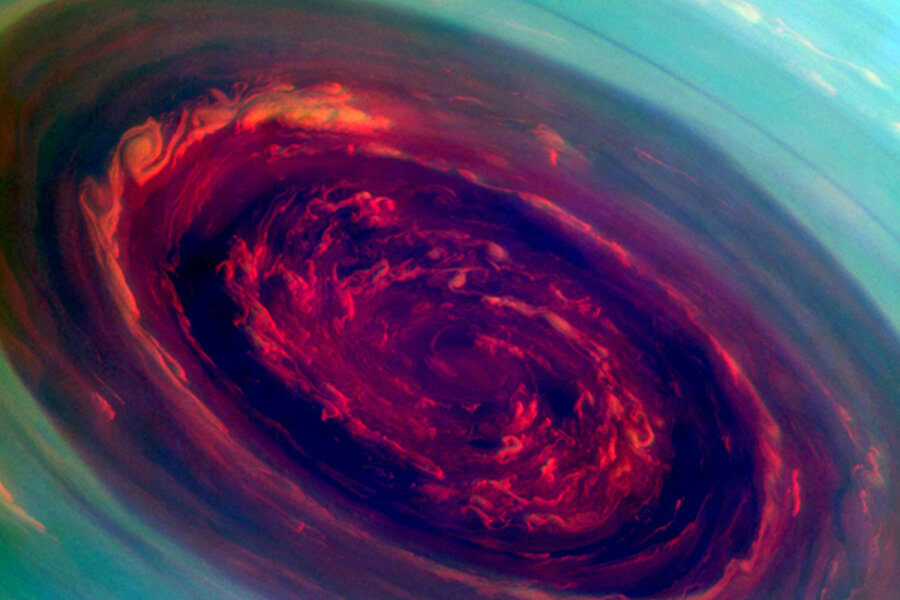What's a monster hurricane doing on top of Saturn?
Loading...
NASA's Cassini spacecraft has captured images of a monster hurricane at Saturn's north pole – a storm so vast and powerful it makes tropical cyclones on Earth look tame by comparison.
The storm's eye alone spans some 1,250 miles – about the distance from North Carolina's Outer Banks to central Kansas. Wind speeds at the inner eye wall have been clocked at 330 miles an hour. The storm extends for another 600 to 700 miles beyond the eye.
Like a hurricane eye on Earth, the eye of Saturn is virtually cloudless, with tall clouds forming the eye wall and extending out from the eye.
"We did a double take when we saw this vortex because it looks so much like a hurricane on Earth," Andrew Ingersoll, a planetary scientist at the California Institute of Technology in Pasadena, Calif., and a member of the Cassini science team, said in a prepared statement. "But there it is at Saturn, on a much larger scale."
Saturn's no-name storm sits nearly dead center inside another odd feature: a hexagonal ring of high-speed winds analogous to Earth's polar jet streams, high-altitude winds that circle the globe at high latitudes.
The hexagon is about the size of Jupiter's Great Red Spot, a feature that would cover two to three Earths side by side, Dr. Ingersoll explained in an interview.
Saturn's polar storm is small compared with Jupiter's Great Red Spot, the current record-holder for largest storm on any planet in the solar system. That storm sits in Jupiter's southern hemisphere at a latitude comparable to the central coast of Queensland in Australia, where tropical cyclones frequently make landfall. Winds speeds for the Great Red Spot hover at around 400 miles an hour.
Astronomers have observed Jupiter's ruddy blemish regularly since 1831, although some records hint at an initial observation in the 1600s. Indeed, it may be a permanent feature in the giant planet's atmosphere.
At Saturn, NASA's Voyager missions identified the hexagon feature surrounding Saturn's north polar region some 30 years ago. It was up to Cassini to spot the storm. The craft recorded initial evidence for the hurricane shortly after the craft arrived at Saturn in 2004. Saturn's north pole was cloaked in the darkness of a northern-hemisphere winter that lasts seven years, so the first evidence emerged from infrared measurements. The Cassini team had to wait until spring arrived to gather stunning visual images of the storm.
Studies of Jupiter's Great Red Spot indicate that the energy driving the storm comes from water vapor, as it does with Earth's tropical cyclones. On Saturn, the energy source for the polar storm is a mystery. Seventy-five percent of the planet's atmosphere is hydrogen, roughly 25 percent is helium, along with tiny quantities of other gases and water.
Two energy sources come to mind, Ingersoll says. One is sunlight, which at Saturn's distance is relatively weak compared with the amount of the sun's energy reaching the five planets closer in to the sun. The other energy source is the planet's internal heat, left over from the planet's formation some 4.6 billion years ago.
During the northern hemisphere's seven-year long winter, the planet's internal heat probably keeps the storm going. During the northern hemisphere spring and summer, the two sources can combine to spin up the storm for another Saturnian year pirouetting at the top of the planet.
The storm's winds can maintain their momentum in part because nothing lies beneath the storm to sap it of energy. On Earth, friction with land surfaces sap a hurricane's strength, in addition to a cut-off in the ocean warmth and moisture hurricanes need as fuel, Ingersoll says.
The winds maintain their momentum as well because less sunlight reaches the gas giants. This means each gas-giant's atmosphere exhibits successively less turbulence with distance from the sun. That turbulence also can act as a drag on wind flow. This explains why the fastest winds found so far are on Neptune, even farther from the sun than Saturn, Ingersoll says.
The hexagonal polar jet stream also presents a puzzle. On Earth, the polar jet in the Northern Hemisphere interacts with the continents, contributing to its north-south, river-like meanders. Saturn has no continents.
The length and positions of the hexagon's sides can vary slightly with time, the stream of fast-flowing air nevertheless maintains this general shape around the polar region – a six-sided corral for one of the solar system's most powerful storms.
"I wish I had all the answers" to the puzzles the storm and hexagon pose, Ingersoll says. "But that's life in science."








